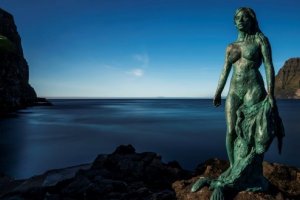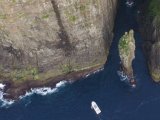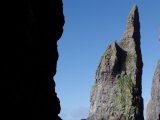Located in the Northeast Atlantic half way between Scotland and Iceland, the Faroe Islands are an archipelago of 18 mountainous islands, boasting unparalleled vistas of wild nature. Black volcanic mountains, lush green meadows, waterfalls, fishing villages and endless adventures! Yes, it is spectacular, unique, untouched and as remote as you would imagine it to be!

Faroe Islands
General Information
Introduction:
The population of the Faroe Islands is largely descended from Viking settlers who arrived in the 9th century. The islands have been connected politically to Denmark since the 14th century. A high degree of self-government was granted the Faroese in 1948, who have autonomy over most internal affairs while Denmark is responsible for justice, defense, and foreign affairs.
General Facts:
- Size: Total Land Area is 538 Sqaure Miles, which is slighly larger than Hong Kong or wight time the size of Washington, DC
- Population: 51,628 people divided into the following ethnic groups: Faroese 87.6% (Scandinavian and Anglo-Saxon descent), Danish 7.8%, other Nordic 1.4%, other 3.2% (includes Filipino, Thai, British)
- Elevation Extrems: Lowest Point is the Atlantic Ocean and the highest point is Slaettaratindur 882 meters (2,894 feet)
- Religion: Christian, predominantly Evangelical Lutheran
- Language: Faroese (derived from Old Norse abd Danish
Entry Requirements:
US Citizens do not need a visa or other permit to visit the Faroe Islands. You may enter with a passport vaild for at least three months beyond the planned stay in the Faroe Islands.
Informations: The World Factbook
When to Travel?
In the middle of the North Atlantic, where the warm waters of the Gulf Stream meet the cold waters of the Arctic, injecting the oceans with their global energy – lie the Faroe Islands, a nation of 50,000 people living at the very heart of the global climate and weather machine.
The Faroese fondly refer to their own country as “the land of maybe” because of its extreme and often unpredictable weather changes.
The weather in the Faroe Islands is mostly cold and humid year-round and while each season brings a different variety experiences, the best time to time to visit the islands is between May to September. Long days are perfect for explorations and in the late spring and early summer the wildflowers and Puffins are in abundance.
July and August are within the Peak Season and therefore a very advance booking is strongly suggested.
The winter (December to February) tend to be extremely cold, however it is when the Northern Lights appear and glow in the sky!
Suggested Journeys
 Faroe Islands - The Hidden Gem of the North Atlantic
Faroe Islands - The Hidden Gem of the North Atlantic5 Days / 4 Nights • Daily Arrival from June through September
A Journey by Private Car and Private Guide
Welcome to the Faroe Islands! Described by some as the Nordic Hawaii. Find out why these islands have been chosen by National Geographic as number 1 among 111 island destinations in the world.
You will experience the islands through all senses. The natural environment is the key ingredient, and you will see it, eat from it, hike in it, sail the sea and also compete in it.
Photo Gallery
 Puffin - Faroe Islands
Puffin - Faroe Islands Village of Bøur -Faroe Islands
Village of Bøur -Faroe Islands Vestmanna Cliffs - Faroe Islands
Vestmanna Cliffs - Faroe Islands Puffins in Mykines Island - Faroe Islands
Puffins in Mykines Island - Faroe Islands Vestmanna Sea Cliffs - Faroe Islands
Vestmanna Sea Cliffs - Faroe Islands The Island of Mykines-Faroe Islands
The Island of Mykines-Faroe Islands Tjørnuvík -Faroe Islands
Tjørnuvík -Faroe Islands Gásadalur, Faroe Islands
Gásadalur, Faroe Islands National Holiday - Faroe Islands
National Holiday - Faroe Islands Sheep in Faroe Islands
Sheep in Faroe Islands